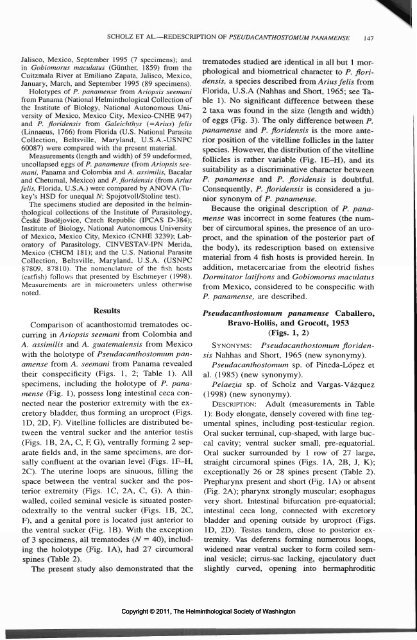The Helminthological Society of Washington - Peru State College
The Helminthological Society of Washington - Peru State College
The Helminthological Society of Washington - Peru State College
You also want an ePaper? Increase the reach of your titles
YUMPU automatically turns print PDFs into web optimized ePapers that Google loves.
SCHOLZ ET AL.—REDESCRIPTION OF PSEUDACANTHOSTOMUM PANAMENSE 147<br />
Jalisco, Mexico, September 1995 (7 specimens); and<br />
in Gobiomorus maculatus (Giinther, 1859) from the<br />
Cuitzmala River at Emiliano Zapata, Jalisco, Mexico,<br />
January, March, and September 1995 (89 specimens).<br />
Holotypes <strong>of</strong> P. panamense from Ariopsis seemani<br />
from Panama (National <strong>Helminthological</strong> Collection <strong>of</strong><br />
the Institute <strong>of</strong> Biology, National Autonomous University<br />
<strong>of</strong> Mexico, Mexico City, Mexico-CNHE 947)<br />
and P. floridcnsis from Galeichthys (= Arius) felis<br />
(Linnaeus, 1766) from Florida (U.S. National Parasite<br />
Collection, Beltsville, Maryland, U.S.A.-USNPC<br />
60087) were compared with the present material.<br />
Measurements (length and width) <strong>of</strong> 59 undeformed,<br />
uncollapsed eggs <strong>of</strong> P. panamense (from Ariopsis seemani,<br />
Panama and Colombia and A. assimilis, Bacalar<br />
and Chetumal, Mexico) and P. floridensis (from Arius<br />
felis, Florida, U.S.A.) were compared by ANOVA (Tukey's<br />
HSD for unequal N; Spojotvoll/Stoline test).<br />
<strong>The</strong> specimens studied are deposited in the helminthological<br />
collections <strong>of</strong> the Institute <strong>of</strong> Parasitology,<br />
Ceske Budejovice, Czech Republic (IPCAS D-384);<br />
Institute <strong>of</strong> Biology, National Autonomous University<br />
<strong>of</strong> Mexico, Mexico City, Mexico (CNHE 3239); Laboratory<br />
<strong>of</strong> Parasitology, CINVESTAV-IPN Merida,<br />
Mexico (CHCM 181); and the U.S. National Parasite<br />
Collection, Beltsville, Maryland, U.S.A. (USNPC<br />
87809, 87810). <strong>The</strong> nomenclature <strong>of</strong> the fish hosts<br />
(catfish) follows that presented by Eschmeyer (1998).<br />
Measurements are in micrometers unless otherwise<br />
noted.<br />
Results<br />
Comparison <strong>of</strong> acanthostomid trematodes occurring<br />
in Ariopsis seemani from Colombia and<br />
A. assimilis and A. guatemalensis from Mexico<br />
with the holotype <strong>of</strong> Pseudacanthostomum panamense<br />
from A. seemani from Panama revealed<br />
their conspecificity (Figs. 1, 2; Table 1). All<br />
specimens, including the holotype <strong>of</strong> P. panamense<br />
(Fig. 1), possess long intestinal ceca connected<br />
near the posterior extremity with the excretory<br />
bladder, thus forming an uroproct (Figs.<br />
ID, 2D, F). Vitelline follicles are distributed between<br />
the ventral sucker and the anterior testis<br />
(Figs. IB, 2A, C, F, G), ventrally forming 2 separate<br />
fields and, in the same specimens, are dorsally<br />
confluent at the ovarian level (Figs. 1F-H,<br />
2C). <strong>The</strong> uterine loops are sinuous, filling the<br />
space between the ventral sucker and the posterior<br />
extremity (Figs. 1C, 2A, C, G). A thinwalled,<br />
coiled seminal vesicle is situated posterodextrally<br />
to the ventral sucker (Figs. IB, 2C,<br />
F), and a genital pore is located just anterior to<br />
the ventral sucker (Fig. IB). With the exception<br />
<strong>of</strong> 3 specimens, all trematodes (TV = 40), including<br />
the holotype (Fig. 1A), had 27 circumoral<br />
spines (Table 2).<br />
<strong>The</strong> present study also demonstrated that the<br />
trematodes studied are identical in all but 1 morphological<br />
and biometrical character to P. floridensis,<br />
a species described from Arius felis from<br />
Florida, U.S.A (Nahhas and Short, 1965; see Table<br />
1). No significant difference between these<br />
2 taxa was found in the size (length and width)<br />
<strong>of</strong> eggs (Fig. 3). <strong>The</strong> only difference between P.<br />
panamense and P. floridensis is the more anterior<br />
position <strong>of</strong> the vitelline follicles in the latter<br />
species. However, the distribution <strong>of</strong> the vitelline<br />
follicles is rather variable (Fig. 1E-H), and its<br />
suitability as a discriminative character between<br />
P. panamense and P. floridensis is doubtful.<br />
Consequently, P. floridensis is considered a junior<br />
synonym <strong>of</strong> P. panamense.<br />
Because the original description <strong>of</strong> P. panamense<br />
was incorrect in some features (the number<br />
<strong>of</strong> circumoral spines, the presence <strong>of</strong> an uroproct,<br />
and the spination <strong>of</strong> the posterior part <strong>of</strong><br />
the body), its redescription based on extensive<br />
material from 4 fish hosts is provided herein. In<br />
addition, metacercariae from the eleotrid fishes<br />
Donnitator latifrons and Gobiomorus maculatus<br />
from Mexico, considered to be conspecific with<br />
P. panamense, are described.<br />
Pseudacanthostomum panamense Caballero,<br />
Bravo-Hollis, and Grocott, 1953<br />
(Figs. 1, 2)<br />
SYNONYMS: Pseudacanthostomum floridensis<br />
Nahhas and Short, 1965 (new synonymy).<br />
Pseudacanthostomum sp. <strong>of</strong> Pineda-Lopez et<br />
al. (1985) (new synonymy).<br />
Pelaezia sp. <strong>of</strong> Scholz and Vargas-Vazquez<br />
(1998) (new synonymy).<br />
DESCRIPTION: Adult (measurements in Table<br />
1): Body elongate, densely covered with fine tegumental<br />
spines, including post-testicular region.<br />
Oral sucker terminal, cup-shaped, with large buccal<br />
cavity; ventral sucker small, pre-equatorial.<br />
Oral sucker surrounded by 1 row <strong>of</strong> 27 large,<br />
straight circumoral spines (Figs. 1A, 2B, J, K);<br />
exceptionally 26 or 28 spines present (Table 2).<br />
Prepharynx present and short (Fig. 1A) or absent<br />
(Fig. 2A); pharynx strongly muscular; esophagus<br />
very short. Intestinal bifurcation pre-equatorial;<br />
intestinal ceca long, connected with excretory<br />
bladder and opening outside by uroproct (Figs.<br />
ID, 2D). Testes tandem, close to posterior extremity.<br />
Vas deferens forming numerous loops,<br />
widened near ventral sucker to form coiled seminal<br />
vesicle; cirrus-sac lacking, ejaculatory duct<br />
slightly curved, opening into hermaphroditic<br />
Copyright © 2011, <strong>The</strong> <strong>Helminthological</strong> <strong>Society</strong> <strong>of</strong> <strong>Washington</strong>
















